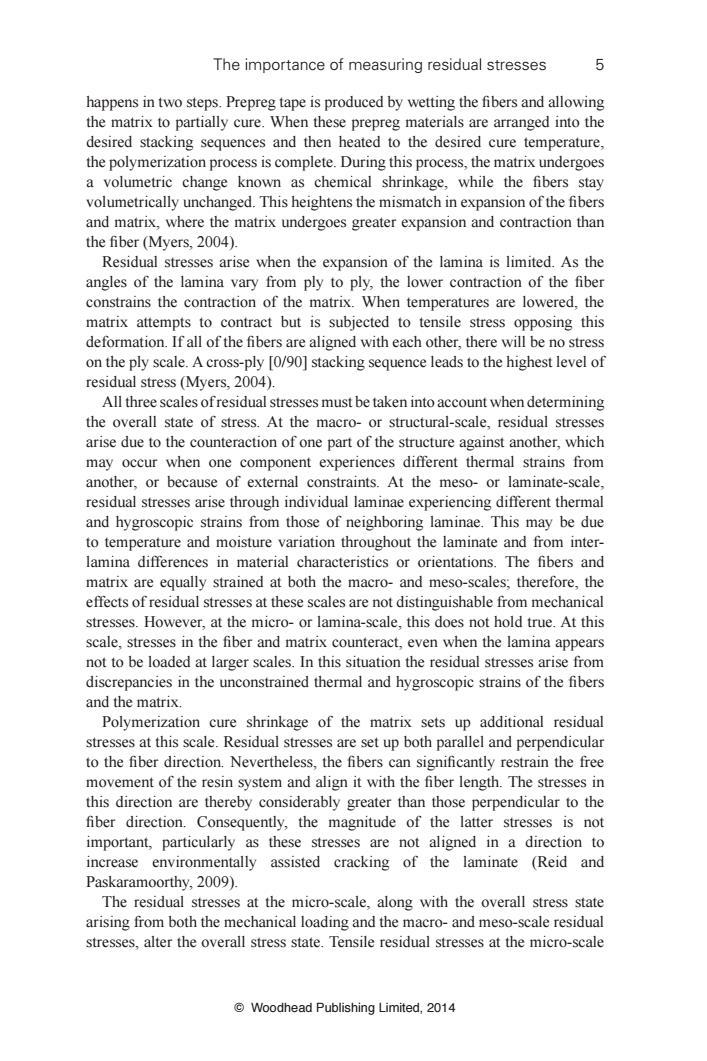正在加载图片...

The importance of measuring residual stresses 5 happens in two steps.Prepreg tape is produced by wetting the fibers and allowing the matrix to partially cure.When these prepreg materials are arranged into the desired stacking sequences and then heated to the desired cure temperature, the polymerization process is complete.During this process,the matrix undergoes a volumetric change known as chemical shrinkage,while the fibers stay volumetrically unchanged.This heightens the mismatch in expansion of the fibers and matrix,where the matrix undergoes greater expansion and contraction than the fiber (Myers,2004). Residual stresses arise when the expansion of the lamina is limited.As the angles of the lamina vary from ply to ply,the lower contraction of the fiber constrains the contraction of the matrix.When temperatures are lowered,the matrix attempts to contract but is subjected to tensile stress opposing this deformation.If all of the fibers are aligned with each other,there will be no stress on the ply scale.A cross-ply [0/90]stacking sequence leads to the highest level of residual stress(Myers,2004). All three scales ofresidual stresses must be taken into account when determining the overall state of stress.At the macro-or structural-scale,residual stresses arise due to the counteraction of one part of the structure against another,which may occur when one component experiences different thermal strains from another,or because of external constraints.At the meso-or laminate-scale. residual stresses arise through individual laminae experiencing different thermal and hygroscopic strains from those of neighboring laminae.This may be due to temperature and moisture variation throughout the laminate and from inter- lamina differences in material characteristics or orientations.The fibers and matrix are equally strained at both the macro-and meso-scales;therefore,the effects of residual stresses at these scales are not distinguishable from mechanical stresses.However,at the micro-or lamina-scale,this does not hold true.At this scale,stresses in the fiber and matrix counteract,even when the lamina appears not to be loaded at larger scales.In this situation the residual stresses arise from discrepancies in the unconstrained thermal and hygroscopic strains of the fibers and the matrix. Polymerization cure shrinkage of the matrix sets up additional residual stresses at this scale.Residual stresses are set up both parallel and perpendicular to the fiber direction.Nevertheless,the fibers can significantly restrain the free movement of the resin system and align it with the fiber length.The stresses in this direction are thereby considerably greater than those perpendicular to the fiber direction.Consequently,the magnitude of the latter stresses is not important,particularly as these stresses are not aligned in a direction to increase environmentally assisted cracking of the laminate (Reid and Paskaramoorthy,2009). The residual stresses at the micro-scale,along with the overall stress state arising from both the mechanical loading and the macro-and meso-scale residual stresses,alter the overall stress state.Tensile residual stresses at the micro-scale Woodhead Publishing Limited,2014The importance of measuring residual stresses 5 © Woodhead Publishing Limited, 2014 happens in two steps. Prepreg tape is produced by wetting the fi bers and allowing the matrix to partially cure. When these prepreg materials are arranged into the desired stacking sequences and then heated to the desired cure temperature, the polymerization process is complete. During this process, the matrix undergoes a volumetric change known as chemical shrinkage, while the fi bers stay volumetrically unchanged. This heightens the mismatch in expansion of the fi bers and matrix, where the matrix undergoes greater expansion and contraction than the fi ber (Myers, 2004). Residual stresses arise when the expansion of the lamina is limited. As the angles of the lamina vary from ply to ply, the lower contraction of the fi ber constrains the contraction of the matrix. When temperatures are lowered, the matrix attempts to contract but is subjected to tensile stress opposing this deformation. If all of the fi bers are aligned with each other, there will be no stress on the ply scale. A cross- ply [0/90] stacking sequence leads to the highest level of residual stress (Myers, 2004). All three scales of residual stresses must be taken into account when determining the overall state of stress. At the macro- or structural- scale, residual stresses arise due to the counteraction of one part of the structure against another, which may occur when one component experiences different thermal strains from another, or because of external constraints. At the meso- or laminate- scale, residual stresses arise through individual laminae experiencing different thermal and hygroscopic strains from those of neighboring laminae. This may be due to temperature and moisture variation throughout the laminate and from interlamina differences in material characteristics or orientations. The fi bers and matrix are equally strained at both the macro- and meso- scales; therefore, the effects of residual stresses at these scales are not distinguishable from mechanical stresses. However, at the micro- or lamina- scale, this does not hold true. At this scale, stresses in the fi ber and matrix counteract, even when the lamina appears not to be loaded at larger scales. In this situation the residual stresses arise from discrepancies in the unconstrained thermal and hygroscopic strains of the fi bers and the matrix. Polymerization cure shrinkage of the matrix sets up additional residual stresses at this scale. Residual stresses are set up both parallel and perpendicular to the fi ber direction. Nevertheless, the fi bers can signifi cantly restrain the free movement of the resin system and align it with the fi ber length. The stresses in this direction are thereby considerably greater than those perpendicular to the fi ber direction. Consequently, the magnitude of the latter stresses is not important, particularly as these stresses are not aligned in a direction to increase environmentally assisted cracking of the laminate (Reid and Paskaramoorthy, 2009). The residual stresses at the micro- scale, along with the overall stress state arising from both the mechanical loading and the macro- and meso- scale residual stresses, alter the overall stress state. Tensile residual stresses at the micro- scale